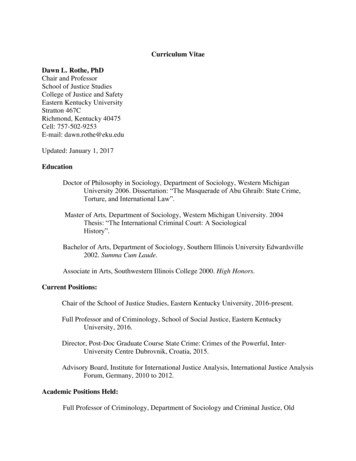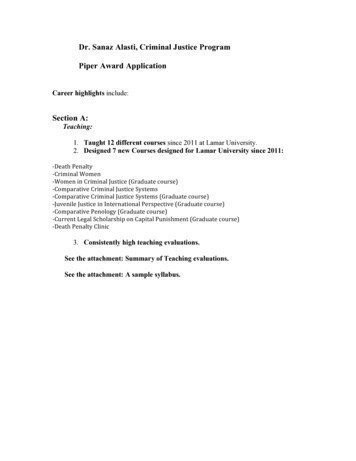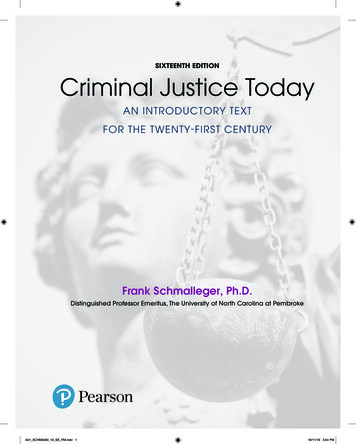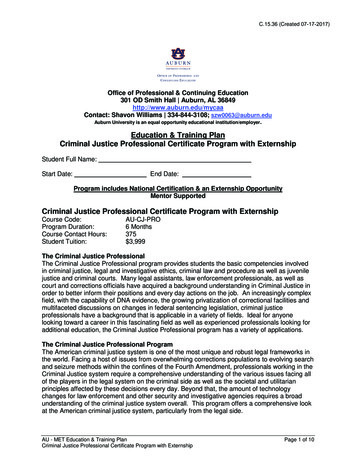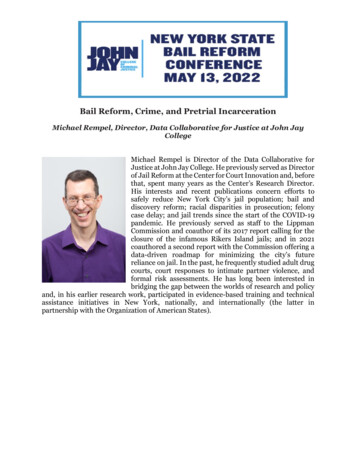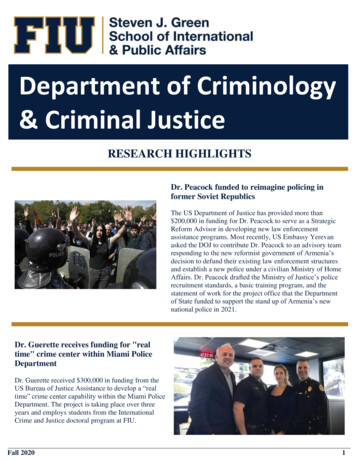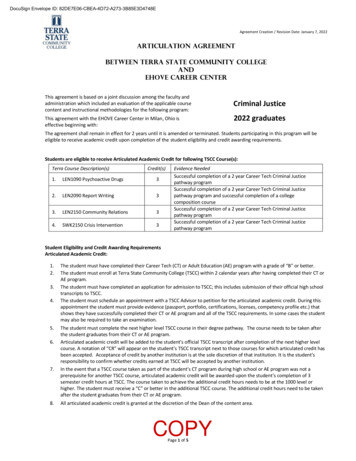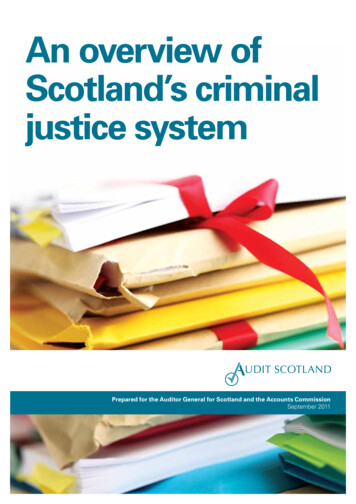
Transcription
Introduction toCriminal JusticePhilosopher John Locke argued that all human beings areendowed with what he called “natural rights.” These rightsare given to people by a power higher than government,and people cannot be deprived of them. klickable/Fotolia123456M01 FAGI3802 01 SE C01.indd 1Describe the public-order (crime-control) and individualrights (due process) perspectives of criminal justice andexplain how the criminal justice system balances the two.Describe the structure of the criminal justice system.Outline the fundamentals of the criminal justice process.Summarize major events that led to changes in theAmerican criminal justice system.Summarize a defendant’s due process rights.Summarize criminology, criminal law, and criminal justice.11/2/14 7:03 AM
INTROCompromise: The Glue That Holds Us Togetherpersonnel, and President Obama abolished military proThe criminal justice system encapsulates the changinghibitions against same-sex couples. In 2013, 13 statessocial norms and values of the society. Some changesand the District of Columbia have legalized same-sexresult in laws changing slowly over decades and othermarriages. In 2013, the U.S. Supreme Court declaredchanges occur rapidly. The changing laws related toDOMA unconstitutional.same-sex marriage are an example of the latter. In the1980s, sodomy between same-sex couples was a conThe Court’s ruling triggered numerous changes in thestitutionally upheld crime1 in more than half the states,law. Within a month of the Court’s ruling, the Internalsame-sex marriage was not legal, and homosexuals wereRevenue Service, Social Security Administration, Medidischarged from military sercare, and the military revisedvice. In 1986, Congress passedtheir laws and provided equalthe Defense of Marriage Actbenefits for spouses of same(DOMA) defining marriage as DISCUSS In Elane Photography v. Willock,sex couples. California prisa union between one man andthe New Mexico Supremeons permitted inmates toone woman.marry same-sex partners whoIn 2003, the U.S. SupremeCourt overturned its ruling upholding the constitutionality oflaws criminalizing sex betweensame-sex couples.2 PresidentClinton adopted a “Don’t Ask –Don’t Tell” policy for militaryCourt ruled “a pluralistic societymust be a society of compromiseby definition . . . Compromise is partof the glue that holds us together as anation . . . it is the price of citizenship.”Do you agree?are not incarcerated 3 andin Elane Photography, LLC v.Willock, the New Mexico Courtruled there was a moral andlegal equivalence between racial discrimination and sexual discrimination.4 Balancing Public Safety and Unalienable RightsWhat does society do when there appears to be a conflict overdue process rights or over what should be legal behavior andone party has to compromise? In cases where there is outrightconflict, as to the rights claimed by one group but opposed byanother group, the criminal justice system plays an importantrole in resolving the conflict. When changing social valuesand norms result in conflicts between what the laws say are legal behavior and in the current morality, often there must bechanges made to the criminal justice system. Laws may need tobe changed or deleted or new laws may need to be passed.While the Declaration of Independence declares that people have unalienable rights and the U.S. Constitution describesthose rights, from time to time, some of them may be in conflict with popular opinion, the law, or social values. Society usesseveral means to balance conflicting rights and social values.In general, these means can be divided into informal and formal sanctions. Informal sanctions include social norms that areFrequently, the norms and valuesembedded in informal systems arereflected in the formal systems oforder maintenance.TIMELINETimeline of Key Events17881791The ConstitutionThe first ten amendments, known asthe Bill of Rights, are added tothe U.S. Constitution. Theseamendments are the foundation ofthe civil rights and due processrights of citizens.of the newly formedU.S. government isratified by theStates.2Chapter 1M01 FAGI3802 01 SE C01.indd e FourteenthAmendmentguarantees U.S.citizenship and is thebasis for the dueprocess clause of civilrights.1870The Fifteenth Amendmentprohibits the denial of voting rightsbased on race, color, or previousstate of servitude. The FifteenthAmendment does not extendvoting rights to women, onlyto men.Introduction to Criminal Justice1/2/14 7:03 AM
The more homogeneous and stablethe people and their belief systems, thefewer the violations of social norms.enforced through the social forces of the family, school, government, and religion. These social institutions teach people whatis expected for normative behavior. In addition to teaching normative behavior, these primary social institutions also providepunishment when people violate social norms. In the informalsystem, parents punish children for disobedience, bosses reprimand employees, teachers discipline students, and religiousgroups call on offenders to repent of their sins.The balancing of rights and public safety can also beachieved through use of formal sanctions (such as laws) foundwithin the criminal justice system. Frequently, the norms andvalues embedded in informal systems are reflected in the formal systems of order maintenance. The more homogeneousand stable the people and their belief systems, the fewer theviolations of social norms. In a homogeneous, stable societywith a common belief system, there is less need for reliance ona formal system of social control to maintain order and regulate interactions. Social control systems operate most effectivelyand efficiently where there is constant and unified, overt andcovert, and cultural and social support from all control agencies.5 However, contemporary U.S. society is not characterizedby a homogeneous and stable group of people with a commonbelief system. Rather, the United States is characterized by greatdiversity in race, religion, ethnicity, and values.Limited Powers of GovernmentIn Two Treatises of Government (1690), philosopher John Lockeargued that all human beings are endowed with what he called“natural rights.” These rights are given to people by a powerhigher than government, and people cannot be deprived ofthem. Governments exist, according to Locke, to serve individuals. People surrender certain rights with the understanding that they will receive as much, or more, in other benefits,such as safety, order, and preservation of property rights. Locke1896The U.S. Supreme Courtcase of Plessy v.Ferguson establishes the“separate but equal”doctrine of racial discrimination that permitted thelegal separation of whitesand blacks.1920TheNineteenthAmendmentextends votingrights to women.1941Broadcasttelevisionbegins in theUnited States.conceded that the governmentmust have the power of physical force to protect peopleand their property from thephysical violations of others.6However, this power was tobe balanced against the needto preserve individual liberty.John Locke’s philosophies hada great influence on ThomasJefferson when he drafted theDeclaration of Independence.7When there is conflict between rights, often the U.S.Court system decides whichrights are to be sanctioned.For example, the U.S. SupremeCourt has recognized the rightof people who have conscientious objections to killing tobe exempted from combatservice (the exemption doesnot exempt them from military service when required bylaw), the right to refuse childhood immunizations requiredby law, the right to withdrawchildren from public schoolbefore the age allowed by law,the right of Amish to be exempt from paying Social Security taxes, the right of Jews tobe exempt from military rulesthat forbid nonuniform headcoverings, and the right of Native Americans to use certaindrugs in religious ceremonies and gather eagle feathers(which is prohibited by law fornonnative Americans). Oftenconflicts between competing1954Learning Describe the publicOutcomes order (crime-control)1and individual-rights(due process)perspectives of criminal justiceand explain how the criminaljustice system balances the two.Glossaryinformal sanctions Social normsthat are enforced through thesocial forces of the family, school,government, and religion.social norms The expected normative behavior in a society.formal sanctions Social normsenforced through the laws of thecriminal justice system.order maintenance Activitiesof law enforcement that resolveconflicts and assist in the regulation of day-to-day interactions ofcitizens.system of social control A socialsystem designed to maintain orderand regulate interactions.due process rights Rights guaranteed to persons by the Constitution and its amendments.crime-control (public-order)model A model of the criminaljustice system in which emphasisis placed on fighting crime andprotecting potential victims.due process model A modelthat ensures that individualsare protected from arbitrary andexcessive abuse of power by thegovernment.1955Brown v. Board of Educationdeclares state laws establishingseparate public schools for blackand white students unconstitutional. The decision overturned thePlessy v. Ferguson decision of1896 that established the doctrineof “separate but equal” racialsegregation.Rosa Parks is arrested andconvicted for refusing to give upher seat to a white passenger on abus. Her arrest initiates the381-day Montgomery bus boycottand many acts of civildisobedience.Balancing Public Safety and Unalienable RightsM01 FAGI3802 01 SE C01.indd 331/2/14 7:03 AM
TIMELINETimeline of Key Events1961196319641964Civil rights workers attempt todesegregate bus stations andwaiting rooms in the South. Abus in which they aretraveling is fire-bombed, andthe demonstrators arebeaten. NAACP leaderMedgar Evers is murdered.Martin LutherKing, Jr., (1929–1968)The Civil Rights Act of 1964 bans discrimination onMartin Luther King, Jr.,is the youngest person toreceive the Nobel PeacePrize for his work to endracial segregation and racialdiscrimination through civildisobedience and othernonviolent means.delivers his “I Have aDream” speech in theMarch on Washington.the bases of race and gender by facilities that are opento the public, such as hotels, restaurants, theaters, retailstores, and similar establishments. Also, it extendsgreater protection for the right to vote. The Civil Rights Actof 1964 does not extend the ban on racial discriminationto state and local government. Thus, state and local lawenforcement agencies and correctional agencies are notprohibited from racial discrimination.norms and values that are embodied in the law are resolved bythe Supreme Court. The Supreme Court is the final arbitratoras to which rights are considered unalienable and who has tocompromise. The Supreme Court has made many decisionsthat have resulted in significant changes in legal and social behavior. Many more major decisions will follow.Crime Control versus Due ProcessIn the Declaration of Independence, Thomas Jefferson embedded Locke’s arguments that government is limited in its power.This philosophy was further asserted in the Constitution andits amendments. Thus, the government has the power to act asfinal arbitrator of which rights are to be sanctioned, but thereare checks and balances on this power. The government ischarged with maintaining harmony among conflicting interestsand sanctioning those who violate the rights of others. However, the government is restricted in the powers and actions itmay use in its pursuit of maintaining law and order in society.The rights guaranteed to persons by the Constitution andits amendments are called due process rights . There is nouniversal agreement as to what powers the government mayexercise in the pursuit of law and order. Some would givethe government more power and citizens few rights to tipthe scale toward greater public order. Others would give thegovernment less power and citizens more rights to achieve anacceptable level of crime control but maintain strict limits ongovernment power.There must be a balance between law and order and dueprocess rights. Law without order is anarchy, but order without law is tyranny. In the United States, the emphasis on publicorder or crime control versus emphasis on due process rightsresembles a pendulum that swings back and forth between thetwo values.Concern for due process swung to its most liberal extent inthe 1960s under Chief Justice Earl Warren and then back to theright again with the “law and order” platform on which RichardNixon based his campaign for the presidency. Nixon’s term aspresident (1969–1974) was characterized by a period of socialunrest, violent protests and demonstrations, and high crimerates. Crime was the number one fear of citizens, and manypeople were receptive to the promise of crime control, publicorder, and swift—preferably harsh—justice for the offender.Crime control cannot be achievedat the expense of constitutionallyprotected liberties.TIMELINETimeline of Key Events19681968Martin Luther King, Jr., The Omnibus Crime Control and Safe StreetsAct is passed. The act establishes the Law Enforcementis assassinated.Administration Assistance (LEAA), which provides funding,training, and professionalization of the criminal justicesystem. LEAA implements many of its standards throughthe power of the “purse strings.” Agencies lose LEAAfunding if they do not adopt the standards advocated byLEAA. LEAA is abolished in 1982.4Chapter 1M01 FAGI3802 01 SE C01.indd 41968–19821970The Law EnforcementEducation Program (LEEP),On the Kent Stateunder the Law EnforcementAdministration Assistance,undertakes the mission ofraising the educational level ofcriminal justice personnel byfunding grants and loans tothose seeking college degrees.University (Ohio)campus, NationalGuard troops openfire on unarmedstudents protestingU.S. involvement inthe Vietnam War. Fourstudents are killed.Introduction to Criminal Justice1/2/14 7:03 AM
1965Malcolm X (1925–1965), also known as MalcolmLittle and El Haji Malik El-Shabazz, is assassinated bymembers of the Nation of Islam, an activist group thatadvocates black supremacy and separation of blacksand whites in the United States. Until a year before hismurder, Malcolm X was a leader in the Nation of Islam,when he renounced the Nation of Islam and advocatedmore peaceful coexistence of the races.(A Gallup Poll reportsthat Americans viewcrime as the mostserious problem in thecountry.19651965–1973PresidentLyndon JohnsonU.S. troops are committed todeclares War onCrime.the Vietnam War. In 1975, NorthVietnam captures Saigon andVietnam is united.Think About It It is essential that citizens believe the criminal justice system exists to serve and protect thecommunity in a fair and unbiased manner. Corruption, abuse, bias, and even incompetency candiminish this trust. One practice that has raised citizen’s concern across the United States is the useof traffic cameras to issue citations to motorists for speeding and red light violations.8 In large cities,such enforcement tactics can produce tens of millions of dollars in revenue.9 Numerous allegationsof bribery are associated with the awarding of contracts.10 Many citizens feel that traffic cameras arerevenue generators for the city and have little to do with public safety.11 What do you think?This emphasis on efficient and effective justice is known as thecrime-control (public-order) model of criminal justice.However, crime control cannot be achieved at the expenseof constitutionally protected liberties. The emphasis on ensuring that individuals are protected from arbitrary and excessiveabuse of power by the government is known as the due processmodel of criminal justice. Due process means that in the questfor crime control and public order, the government is bound tofollow certain rules and procedures. Even if a person is guilty,if the government does not follow the rules and procedures inobtaining a conviction, the courts can refuse to prosecute thealleged offender or void a conviction obtained in violation ofthese rights.19711972The Twenty-SixthAmendment lowersThe Equal Rights Amendment(ERA) is introduced. The Amendmentthe voting age from 21to 18.would ban discrimination on the basisof gender. Despite a three-yearextension, the Amendment fails toobtain ratification by a sufficientnumber of states to become law, andthe proposal dies in 1982.One of the primary roles of the state and federal courts is toprovide authoritative guidance as to the proper balance betweendue process and crime control that should be exercised by criminaljustice personnel and agencies. Often the guidelines of the Courtare the result of cases of alleged violation of constitutional and dueprocess rights by law enforcement, the courts, or correctional personnel. For example, one of the best-known guidelines issued bythe U.S. Supreme Court came from Miranda v. Arizona (1966), inwhich the Court mandated the specific due process rights that lawenforcement must follow in arrest and interrogation of accusedpersons. The due process model reflects belief in the saying thatit is better that a guilty person should escape the punishment ofjustice than an innocent person be wrongfully punished.1972The Equal Employment Opportunity Act of 1972 extends theprovisions of the Civil Rights Act of 1964. The act gives the Equal EmploymentOpportunity Commission the authority to file class-action lawsuits and extendsthe jurisdiction of the act to cover state and local governments. The effect is torequire state and local law enforcement agencies and correctional agencies,which had previously been exempt from the prohibitions against discrimination based on race and gender, to abolish discriminatory hiring, employment,and promotional practices.Balancing Public Safety and Unalienable RightsM01 FAGI3802 01 SE C01.indd 5) styleuneed/Fotolia196551/2/14 7:03 AM
TIMELINETimeline of Key Events1972The President’sCommission on LawEnforcement andAdministration ofJustice concludes thatmost people have lostconfidence in the police.1995200120012010The number of seriousviolent crimes begins adecline that continuesthrough the late 1990sand into the 2000s,when the numbers beginto level off.Hijacked commercialairplanes strike thetowers of the WorldTrade Center and thePentagon. A thirdplane crashes inPennsylvania.PresidentGeorge W. BushThe Second Amendment isincorporated. The U.S. SupremeCourt rules that the SecondAmendment provides individualsthe right to own firearms. The Structure of the CriminalJustice SystemDuring the 1960s, the public lost faith in the criminal justicesystem. Rising crime rates, riots, demonstrations against theVietnam War, and racial conflict resulted in many people believing that the criminal justice system was “broken” or wasa “nonsystem.” Concerned over the public’s ebbing faith inthe ability of government to maintain public safety, PresidentLyndon Johnson appointed a commission of experts from thecriminal justice system, government, public, and academiccommunity to examine the criminal justice system, describethe criminal justice process, and make recommendations to improve it. The commission was called the President’s Commission on Law Enforcement and Administration of Justice. One ofthe main charges of the Commission was to determine whetherthe process of administration of justice in the United States wasa system and, if so, to define the criminal justice system. TheCommission issued a report in 1967 entitled The Challenge ofCrime in a Free Society. The Commission’s report concludedthat there was indeed a criminal justice system and provided anoutline of the agencies and processes that comprised it.12The Commission concluded that the criminal justice system was composed of (1) the agencies and people involved inthe criminal justice system and (2) the processes and flow ofthe criminal justice system. Furthermore, the Commission concluded that the criminal justice system was a dynamic system,constantly adjusting and changing. This dynamic nature was duein large part to the interactions between agencies, the operationof checks and balances within the system, and changing environments such as new laws and U.S. Supreme Court decisions. Also,the Commission acknowledged the dual nature of the criminaljustice system; that is, the criminal justice system is not a singlesystem but is comprised of the criminal justice system of each ofthe 50 states and the federal criminal justice system.Today, the criminal justice system is widely recognized as asignificant component of federal, state, and local governments.The criminal justice system employs more than 2.5 millionpeople and spends more than 228 billion per year. The percapita justice expenditures are about 755 per U.S. resident.136Chapter 1M01 FAGI3802 01 SE C01.indd 6declares War onTerrorism. TheUSA PATRIOTAct is passed.In 2011, the expenditures by the criminal justice system wereflat or slightly declining, but from 1982 to 2007, the expenditures for criminal justice increased 171%.14Agencies in the Criminal Justice SystemCriminal justice agencies can be divided into (1) law enforcement; (2) prosecutors and the courts; (3) the probation and parole agencies; and (4) the jails, prisons, and other correctionalagencies. These agencies exist in the local, state, and federal levels of government. Each level of government has its own criminaljustice agencies and process. Thus, there is not a single criminaljustice system, but an interconnected system of criminal justiceagencies at the local, state, and federal level. Also, there is a separate but interconnected criminal justice system for adults and juveniles at both the state and federal level of government.Dual Criminal Justice SystemThe U.S. criminal justice system is distinct from criminal justice systems of other nations in which there is a centralizedsystem of oversight and command from top to bottom. TheAmerican system can be described as a dual system, which refers to the fact that the federal government and the states eachhave the power to create their own semiautonomous criminaljustice system. While all criminal justice systems must preservethe rights guaranteed by the U.S. Constitution, there is great diversity between states and the federal government in the detailsof their criminal justice systems.Thus, while 2.5 million people are employed by the criminaljustice system, each of the thousands of criminal justice agencieshires its own employees. There is no central employment agencyfor the criminal justice system. Each agency sets standards ofemployment, defines job responsibilities and duties, and pays2.5million Numberof peopleemployed inthe criminal justice system.Introduction to Criminal Justice1/2/14 7:03 AM
its employees independently of central control. As a result, thereis great diversity in the educational achievement, skills, knowledge, and abilities of the people who work in the criminal justice system. One law enforcement agency may require officers tohave only a high school diploma, whereas another law enforcement agency may require a bachelor’s degree. One state mayhave no requirements of legal training for its municipal judges,whereas another state may require that municipal judges meetstrict standards for education and other qualifications.Sometimes the interrelationship of local, state, and federalcriminal justice agencies is described in a hierarchical relationship by comparing them to a three-layer cake—a broad layerconsisting of local agencies on the bottom, a small layer of stateagencies on top of that layer, and a smaller layer consisting offederal agencies on the top. However, the analogy of a threelayer cake suggests that each political entity is separate and thatthere is a hierarchy with local political entities at the bottomand federal government at the top. This analogy does not accurately describe the criminal justice system. Because of thesemiautonomous nature of criminal justice agencies, althoughthe agencies may interact often, the agencies are independentand there is no hierarchical authoritative relationship betweenthem. For example, the Federal Bureau of Investigation does nothave administrative powers over state law enforcement agenciesand state law agencies do not have administrative powers overlocal law enforcement agencies. The court system does have ahierarchical relationship in that higher courts can overturn thedecisions of lower courts, but separation and independence stillexist among the various local, state, and federal courts.A better analogy to describe the relationship between thelocal, state, and federal criminal justice agencies is the picketfence model. In this analogy, the three horizontal boards in thefence represent the local, state, and federal government and thevertical boards represent the various criminal justice agencies,such as law enforcement, courts, and corrections. Althoughseparate autonomy of each agency is represented by the spacebetween criminal justice agencies at each level of government,an interrelationship is represented by the vertical pickets.LocalGovtC orrec tionsC ourtsStateGovtP olic eFederalGovtPicket Fence ModelChecks and BalancesOne of the characteristics of the criminal justice system is thatit reflects the mistrust of a strong centralized government byEach person and agency in thecriminal justice system has a certainamount of autonomy, but each also iscontrolled by interactions with othercriminal justice agencies.the early founders of the United States. As a result, the U.S. government was created with numerous checks and balances. Eachperson and agency in the criminal justice system has a certainamount of autonomy, but each also is controlled by interactionswith other criminal justice agencies. The balance of authority exercised over other agencies and the authority of agenciesto void actions of other criminal justice agencies is called thepower of checks and balances.The flowchart created by the President’s Commission identifies five stages in the criminal justice system: (1) entry into thesystem, (2) prosecution and pretrial services, (3) adjudication,(4) sentencing and sanctions, and (5) corrections. The agenciesthat compose these stages are semiautonomous, and as discussed earlier, no one agency has the oversight powers to supervise and regulate the processing of an accused person throughthe criminal justice system.This separation of power actsLearning Describe theas checks and balances to enOutcomes structure of thesure fairness and to minimizecriminal justicethe arbitrary exercise of powersystem.or abuse of power by one of theagencies.GlossaryOne of the ways this power criminal justice system Theof checks and balance works isenforcement, by the police, thethat when an accused personcourts, and correctional instituis transferred from one stage tions, of obedience to laws.of the criminal justice systempicket fence model The modelto another, there is the op- of the criminal justice systemportunity for a review of thein which the local, state, andcharges against the accused. federal criminal justice systemsOften at thes e transitionare depicted as horizontal levelspoints, the receiving agencyconnected vertically by the roles,has the authority to refuse to functions, and activities of theagencies that comprise them.continue the processing ofthe accused in the criminalchecks and balances Thejustice system. For example, authority of the legislative branch,the prosecutor may alter thethe executive branch, and thecharges the police filed againstjudicial branch to provide a constitutional check on the actions ofthe accused or may dismiss alleach other.charges and free the accused.The prosecutor must obtainpermission of the court beforethe defendant can be formally tried for the alleged criminalactivity. After the trial and sentencing, the defendant can appeal both the verdict and sentence. Finally, due process rightsensure that when a defendant is transferred to a correctionalfacility, his or her rights regarding cruel and unusual punishment and due process rights to appeal revocation of probationor parole are protected.2The Structure of the Criminal Justice SystemM01 FAGI3802 01 SE C01.indd 771/2/14 7:03 AM
The Criminal Justice ProcessAs mentioned, there is no single criminal justice system. Thus,a discussion of the criminal justice process cannot accuratelydescribe the criminal justice process used by each state andthe federal government. However, the criminal justice systemof each state and the federal government must provide that theconstitutional rights of people who have come in contact withthe criminal justice system are protected. Each person mustbe treated with fairness and equality, and due process rightscannot be abridged. Thus, despite the differences betweenthe criminal justice systems of the various states and the federal government, there is a commonality as governments mustensure that accused people are treated in accordance with therights proscribed by the Constitution and that their journeythrough the criminal justice system is without bias and conforms to the guidelines provided by the Constitution and theU.S. Supreme Court.In 1967, the President’s Commission on Law Enforcementand Administration of Justice undertook one of the first attempts to describe the process of the American criminal justice system.15 Prior to the Commission’s study, there was littleresearch as to the process of the criminal justice system. TheCommission produced a flowchart of the criminal justice system. The flowchart was not reflective of every state’s system,but it did provide a visual depiction of a generalized understanding of the process of the criminal justice system. Sincethe publication of the Commission’s flowchart, the processdescribed by the 1967 report has been updated by other studies and the Bureau of Justice Statistics.16 Thus, the flowchart(Fig
Criminal Justice 1 6 Summarize criminology, criminal law, and criminal justice. 5 Summarize a defendant's due process rights. Summarize major events that led to changes in the 4 American criminal justice system. 3 Outline the fundamentals of the criminal justice process. 2 Describe the structure of the criminal justice system.
